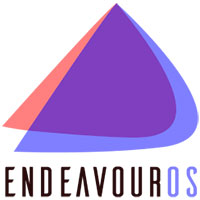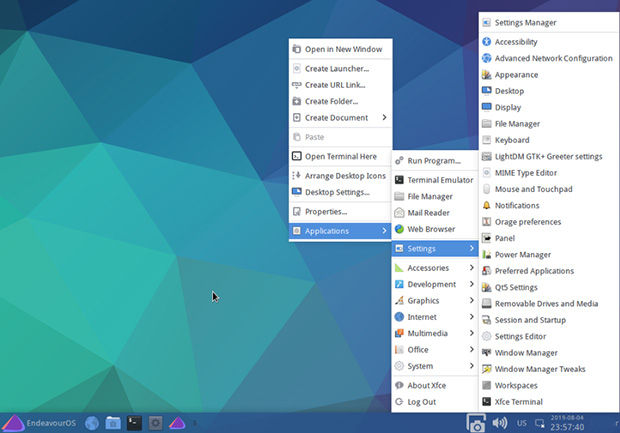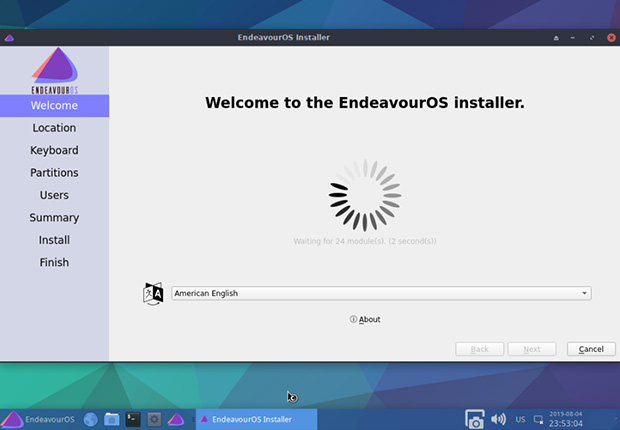
Good-bye Antergos Linux. Welcome to the Arch neighborhood, EndeavourOS. Here’s hoping that you are well received!
That may seem like a strange way to begin this week’s Linux review discussion. After all, Linux distributions come and go far too often. However, the handoff from Antergos to EndeavourOS is significant.
EndeavourOS rolled out its first stable release on July 15. It is a new Arch-based Linux distro that picks up where Antergos left off, in terms of seeking an easy-to-use online installer and modern user-friendlier Arch environment.
Antergos, a popular distro among Arch enthusiasts, shut down in May when its developer team members declared they no longer had time for it. Distros coming and going is an all-too-familiar story in LinuxLand — but it is also the saga that keeps the Linux community thriving with fresh open source participants.
Bryan Poerwoatmodjo (Bryanpwo), project leader and founder of EndeavourOS, was the Antergos community forum moderator. His goal for the new distro — which is not an Antergos clone — is to make the terminal an integral part of the new OS while also providing a GUI for software installation as a small layer of convenience.
EndeavourOS promises something sorely needed. A key component of this new distro is a nontoxic community environment where users actually can get friendly technical help.
The need for a more supportive community is not limited to Arch Linux — other distros could benefit by following EndeavourOS’ lead.
Feature Prospects
EndeavourOS offers users interested in learning about Arch Linux a mixed bag of opportunities. Arch Linux distros tend to be challenging. The EndeavourOS community wants to make Arch a little less so.

Still, the new distro comes with a learning curve. Just because the developers state that they want to make this new distro user-friendly does not mean you can jump right in and find a simple-to-use system waiting for you. Arch ain’t like that!
This first stable release comes with a lightly themed Xfce Desktop environment. It also packs some subtle encouragement to use Arch’s Pacman app for package management needs.
No graphical package manager is included by default. Instead, EndeavourOS uses the familiar Calamares installer to automate the normally complex and command line-based Arch installation process.
There is much more that makes EndeavourOS a good follow-up to Antergos Linux, but before I go any further into telling you what the developers want to do differently, let’s reminisce about the things that stand out about Antergos that might make choosing a replacement upsetting for its orphaned adopters.
Antergos Obituary
Antergos was one of the better Arch Linux options. It was a powerful and modern computing platform that was designed elegantly and brought power users almost all they could desire.
Antergos had a significant history. It was initially the Cinnarch distro, until 2013 when it morphed into Antergos.
One of the biggest challenges in getting started with any Arch distro is surviving the installation. Requiring manual installation routines that rely on a command-line process is the Arch Linux norm. Other Arch-based distros use a combination of scripts to semi-automate the installation routine.
A secondary challenge with Arch-based distros is the software management process. Arch newcomers who get beyond these two factors gain a solid-performing Linux desktop with more layers of security, and a computing system with little or no software bloat.
Common Ground for Something Better
A popular alternative to Antergos was Manjaro Linux. According to Linux folklore, many users adopt Manjaro because it is designed a bit differently than other Arch-based options.
Antergos provided a less frustrating user experience through the installation process. The support options and easy-to-use desktops made Antergos Linux a good fit for most users from that point forward.
Another thing that can trip up users with Arch-based distros is how to start the installation. Most Arch-based ISOs are for direct installation. Typically, Arch distros do not have fully functional live session environments. Those that do require you to exit the live session environment to start the install process externally.
You will not find a live session environment with EndeavourOS, but the distro’s dev team eases the installation pain nonetheless.
The Scoop On EndeavourOS
The Arch software philosophy mostly toes the line, but EndeavourOS is not a strict follower of the entire line. The developers keep the golden Linux and Arch prime directive of freedom of choice in mind, however.
This new distro provides a basic installation process that lets you explore choices such as installing GUI apps like Pacman and software sandbox solutions like Flatpak or Snaps. It is up to the user what gets installed to make EndeavourOS work. Unlike other Arch-based distros, the main difference with this distro is the push to help users who have trouble.
EndeavourOS does not ship with an office suite, an email client or GUI installers like Octopi or Pacman by default. The developers intention in excluding those packages/apps is not to be elitist or Arch purists.
Rather, doing it yourself with the terminal gives you a better understanding of what Pacman or Arch is all about, according to the Wiki on the new distro. In fact, that notion reinforces the basic Arch design philosophy.
Despite that reasoning, the distro includes the yay app by default. Yay is “Yet Another Yogurt,” a common name game for Arch-based packaging tools.
Put simply, Yay is an Arch User Repository, or AUR — a helper for managing packages on Arch Linux. That is a finger in the eye as far as Arch purists are concerned.
Desktop Maven
EndeavourOS ships with the Xfce desktop, but the distro is not limited to Xfce. Again, this is Arch World, so you have choices galore.
Not yet ready is an online installer tool to provide nine more desktop environments: Base, i3-wm, Openbox, Mate, KDE, Cinnamon, Gnome, Deepin and Budgie. Meanwhile, you can install your choice of desktops using the command line.

Again, welcome to Arch. Learn to do the Linux basic things with the keyboard, not the mouse. These commands are fairly straightforward.
Find the commands here. This link takes you to a basic EndeavourOS wiki manual that the developers plan to grow as the distro matures.
Fear No Command-Line Evil
Do not fear the need to use the command line in EndeavourOS. If you are going to use an Arch-based Linux distro, you need to get well acquainted with it. Arch distros rely on the terminal window more than other Linux distro families.
See a list here of the basic Pacman terminal commands to maintain the EndeavourOS system. That will get you started.
Or just click on the Wiki tab on the top of the developer’s website.
Download and Install
Click the Download tab on the EndeavourOS website for a direct link to the distro’s repository. You also can find links there to torrent download locations and other software centers.
The best place to go for the installation ISO is Sourceforge if you are downloading from outside Europe.
Another fast direct download spot is GitHub: direct download, mostly fast.
Either way, you are looking for a file named “endeavouros-2019.07.15-x86_64.iso,” which is 1.4 GB. The file takes about three minutes to download, depending on your source.
I did not find the installation to be difficult. The credit for that is not due to my skill set. The credit goes to the Calamares installer.

Many Arch-based distros still rely fully on the manual installation. Calamares automates most of the installation routines.
Even with Calarames, though, the main stumbling block for novice users will be the fourth step in the process — hard drive partitions.
Calamares creates a graphical look and click approach. It provides options — but you still need to know what the options mean. If that is a potential problem for you, search the Internet for helpful videos.
Bottom Line
EndeavourOS has a lot of potential. It is an impressive addition to the shortlist of distros that want to make using Arch a more rewarding experience.
For a Linux distro built around one of the more challenging Linux families, EndeavourOS is a stable, solid performer with few, if any, noticeable quirks. That shouts volumes, given the relative youth of the first stable release following beta development.
EndeavourOS is not an easy choice for Linux users with no hands-on experience with the Arch Linux ecosystem. Despite its newness, though, it is a better Arch Linux choice than other Arch variants.
It is a great choice for those willing to roll up their sleeves and learn Arch Linux’s inner workings. Hopefully, EndeavourOS succeeds in making the Arch-based neighborhood a more inviting place for new users and seasoned Arch users as well.
Want to Suggest a Review?
Is there a Linux software application or distro you’d like to suggest for review? Something you love or would like to get to know?
Pleaseemail your ideas to me, and I’ll consider them for a future Linux Picks and Pans column.
And use the Reader Comments feature below to provide your input!






















































I’d held off on this one because of its early development status but went ahead today with an online install of their latest release. For me now it’s the best ‘Arch’ experience to date. I chose the KDE desktop option and everything installed perfectly. The initial welcome app sorted out the local mirrors and updates and everything else I needed I got using the included Discover. So far so good but very impressed.
I read somewhere that AUR "helpers" are not for beginners as many would think. What are some thoughts on that? By anyone who wishes to reply? I’m not new to Linux but I’m not accustomed to Arch either. I’m not afraid of a terminal but if I have to spend hours to get something to work, I tend to just use Ubuntu. No offense to any Arch enthusiasts, but I just don’t have the time to continuously fiddle. I do enjoy fiddling if I’m learning something, but it can’t take forever, if you get what I’m talking about.
Endeavour would have to compete with Manjaro rather than the indeed oldish Antergos.